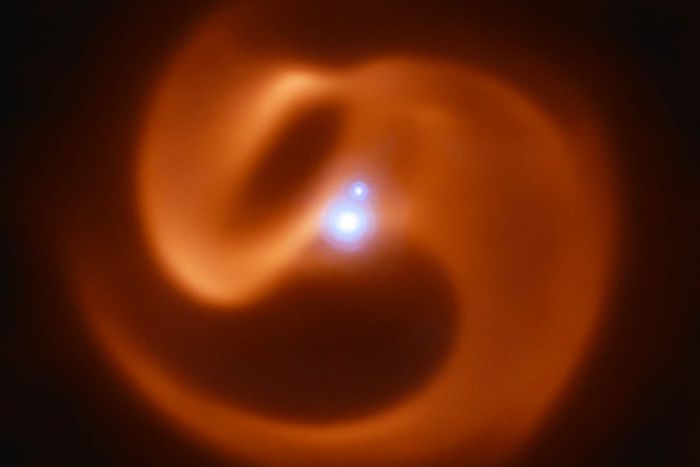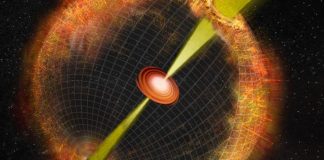
Australian astronomers say they have spotted a super-powerful star that could explode at any moment in one of the most-powerful detonations since the Big Bang.
And this ticking time bomb is not far from Earth.
In a part of the Milky Way 8000-odd light-years away, two stars, each about 30 times bigger than our sun, are circling around each other. Their combined gravity is making each star spin on its axis at incredible speeds.
It’s a final danse macabre before the largest star in the system explodes.
Around them, a vast interstellar dust cloud is whirling at extreme speed, whipped into motion by the stars’ spin.
If a planet was nearby, its inhabitants might look to the sky and see a vast red cloud hurtling across it and two huge stars glowing malevolently within.
Astronomers have named the system Apep, after the Egyptian god of chaos.
When a super-powerful star spins at extremely high speeds, it can explode in a gamma-ray burst: a laser-like jet of extreme energy, the most energetic event we know of. Gamma-ray bursts are so bright they are visible several galaxies away.
If that burst was to hit Earth, half our atmosphere would dissolve in an instant. Some researchers even believe one of these gamma-ray bursts may have been responsible for the death of the dinosaurs.
“Luckily,” says Professor Peter Tuthill, an astronomer at the University of Sydney who was part of the team that studied the dangerous stars, “this one isn’t pointed to us at all – it won’t be coming our way.”
Most massive stars explode in a supernova, but these may explode in much more powerful gamma-ray burst.
That’s because these stars are circling each other and spinning very fast. They are known as Wolf-Rayets.
“They are the T-Rex of the stellar kingdom,” Professor Tuthill says.
“Spin is the secret sauce that turns this from a normal supernova into a titanically powerful gamma-ray burst.
“It’s like a laser beam. It’s the most extreme explosion we know of. They are so bright and powerful we can witness them as far as we can see.”
Luckily, the star’s axis of spin seems to be pointing away from Earth. “The axis of spin can move … But it’s highly unlikely,” Professor Tuthill says.
No gamma-ray burst has ever been observed in the Milky Way, but they are so bright astronomers regularly see them in other galaxies.
It’s not known what causes them, although pairs of Wolf-Rayet stars spinning at high speeds at the prime suspects. The discovery of this system so close to Earth means astronomers will be able to study it and test their theory.
“Systems like this are very, very rare,” says Angel Lopez-Sanchez, an astrophysicist at Macquarie University who studies Wolf-Rayets and was not involved in the research. “It is a very exciting finding.”
The system was spotted by PhD student Dr Joe Callingham while he was sorting through data, and later confirmed using the Anglo-Australian Telescope at Coonabarabran in regional NSW. The findings are published in Nature Astronomy Tuesday.













